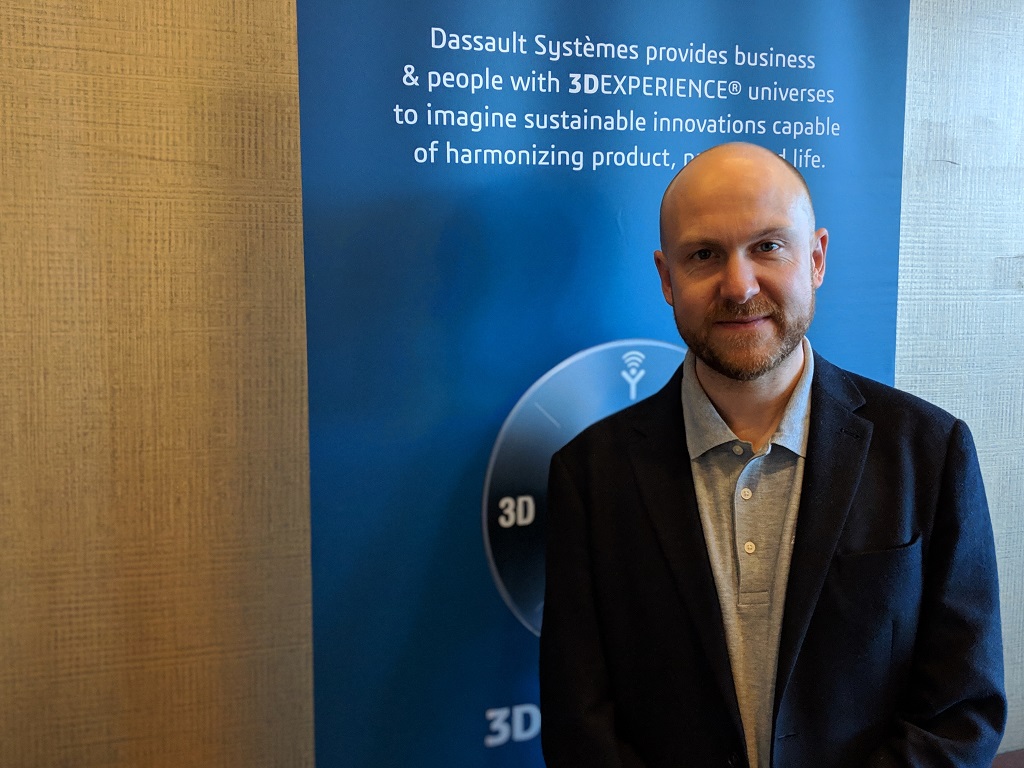![Mark Rushton [Image: Fabbaloo]](https://fabbaloo.com/wp-content/uploads/2020/05/MarkSWW_img_5eb09c481c0a1.jpg)
I sat down with execs from SOLIDWORKS to chat about 3D printing and the popular CAD software.
At this year’s SOLIDWORKS World event, obviously SOLIDWORKS was in focus — but as always, it was much larger than that.
SOLIDWORKS’ parent company, Dassault Systèmes, holds an ever-expanding portfolio of powerful software solutions and an integrated workflow suite. So integrated, in fact, that next year’s event won’t be SWW, but 3DEXPERIENCE World, because it’s all part of this larger experience of 3D. And, of course, 3D printing is an ever-increasing part of that 3D world.
And so it fits that 3D printing is an ever-increasing part of SOLIDWORKS. The 2019 release, as the team shared with us before, has enhanced options for 3D printing along with many more general 3D features.
So where does 3D printing fit into this larger picture?
Mark Ruston, Product Portfolio Manager, SOLIDWORKS, noted that some of the projects he’s been involved with lately have included Textures, Marketplace, and overall SOLIDWORKS connectivity to the larger 3DEXPERIENCE platform.
“We created Textures with 3D printing in mind. It’s not usually on the CAD model, so when you go to print, the texture isn’t there… No one was really asking for it, but that’s what I love to work with, especially when it then gets a big cheer at SOLIDWORKS World,” Rushton said. “We can now also print at a lower resolution, much faster. That’s not something we’d thought of, but was based on some of the feedback we’d been getting.”
Turning to the Marketplace that was announced at last year’s SWW, Rushton noted that it has been helping users become familiar with offerings before directly investing. Marketplaces and service bureaus have been of great value to many in 3D printing, as they offer experts on demand.
“The trouble with the industry is, because it’s so dynamic, people are waiting to see which technologies and vendors will have the longevity before they invest. It can be quite expensive, and people don’t want to buy the wrong thing. Marketplace removes the risk of trying a new supplier,” Rushton said.
That risk has been a hurdle, as “If you find someone who did a bad job it could put you off additive.”
Going through a vetted service like the 3DEXPERIENCE Marketplace ensures that suppliers have already been thoroughly checked for quality. For young technologies like additive manufacturing, one bad experience can often lead to writing off the whole, creating a stutter in adoption and leaving some gap of time before a potential user feels inclined to try again. One bad print can lead to “3D printing is bad”.
That platform thinking of bringing together suppliers extends throughout Dassault’s operations. Finding the right software tool for each application is an important part of success in a job.
“Within the Dassault Systèmes portfolio, there’s some really cool tech that’s even surprised me — stuff I didn’t even think was possible in software,” Rushton enthused.
“Examples are everywhere. With DELMIA there’s the concept of virtual machines — virtual twins of a real 3D printer, running a virtual print before a real prin. With SIMULIA technology built in, you can see if it distorts, put in supports if needed, check residual stresses, and sent to print with either adjusted supports or compensated for distortion.
“This, he said mildly, “is pretty cool.”
SOLIDWORKS integrated into that larger workflow with more capabilities has “always been the plan,” Rushton said. “That message is a lot clearer now.”
SOLIDWORKS has been part of the Dassault Systèmes family since 1997. While some users fear full absorption leading to potential loss of all that makes SOLIDWORKS unique in itself as it becomes more deeply integrated into the Dassault portfolio, that’s ultimately the power of a larger parent. For better or for worse.
Adding the capabilities of other software offerings into a larger-than-its-parts new whole will keep advancing integrated operations. And as additive manufacturing progresses, having more powerful software that works with machine and material and for designer is going to be increasingly necessary.
“Simulation definitely has a big role to play for 3D printing. Design for additive manufacturing is very different from design for CNC or design for other processes,” Rushton said.
“Longer-term, there’s this vision where the roles can merge. Now there’s a designer, then a draftsperson, then an analyst. We’ve seen design and draftsperson merged more, and can see more roles merge. Simulation is more a design tool than an analyst tool. With design guidance in xDesign, essentially topology optimization, we’re getting people to accept this more as a tool for the designer, not as some scary analyst tool. We definitely want to do more with design guidance.”
Merging more roles and merging capabilities into a platform follows a future where 3D printing merges more with general design and manufacturing workflow.
Next up, a further look into 3D printing and software in a chat with SOLIDWORKS’ Suchit Jain, VP of Strategy and Business Development, in part two.
Via SOLIDWORKS











